Lifestyle
Skiing in Pljevlja, today a town without proper ski paths, has a long tradition, and the beginnings of the development of this sport are linked to before the Second World War.
The most credited was Josip Zic from Slovenia, who did not spare any efforts to show the citizens of Pljevlja, especially in the rural area, how to master the skiing technique.
The Belgrade press wrote about his skiing work. In 1940, published under the title "Skis as means of transport by the peasants in Sandzak," it was written that Zic in 1936 "first began to ski in this area".
He did not know how to ski himself when he first arrived from the coast of Istria to Pljevlja, ten years earlier.
Sure, the harsh winters in Pljevlja made him master the skill to ease fulfilling his daily activities.
In Crepoljski, Sarajevo, he completed a course for instructors, and at Kopaonik for a master teacher.
At that time, he also worked as a part-time gym teacher at the High school in Prijepolje.
Citizens of Pljevlja, especially in the rural area, considered him weird because of the hobby he started to pursue.
The man on the two boards, as they called him, for a very short time managed to make the skiing approachable even to the most sceptical ones.
This was also contributed by a story that rapidly spread in the villages of Pljevlja that Zic on the mountain Cemerno, on his return from Rudog, managed to escape the crowd of hungry wolves on his skis.
Knowing that the peasants showed interest in skiing, Zic began to visit the villages of Pljevlja. He even went to the farthest ones, several times. He showed his skis to the villagers, and how to use them as well.
After completing the lectures, Zic would take the drawings from the suitcase, hang them on the wall of the school where he held classes, showing various skiing techniques to his "students".
After several hours of theory, Zic would take the villagers to a nearby hill where he would show them the basics of skiing.
How much interest Zic aroused among the villagers it is shown by the fact that he was known for forming the so-called skiing troops in Crljenica, Mihajlovici, Jabuci, Krći, Gotovusa, Židovići, Čemerno, Crni vrh, Obarda and Hoćevini
"I'm lucky I learned how to ski. That good Slovenian brother Zic taught me and now I can almost compete with him. If I had factory skis I would beat him. Now I use skis when I go to the town to get salt or gas. It takes me a second to get it on my skis. When I need to lay the hay to the cattle, I go on my skis and I’m there in no time. For all this is good, but I have to say that it is best for the evening sessions. Earlier, I couldn’t go to another village. Now I just stand up on my skis and in a short time, I get there. I know that the wolves cannot catch me, and we peasants are not afraid of anything else," the author of the article published in the 1940s in Belgrade's "Stampa", quoting one of the villagers from Cemerno.
In Pljevlja, from 1936 to 1937, several skiing competitions were organized in the villages of Cemerno, Zidovici and Gotovusi. In addition to locals, the army also participated.
The most interesting was the "pure peasant games", which took place in 1936 in the village of Mihailovica.
The path on which adult skiers competed was 10 kilometers long, and half the size for the kids.
In the membership category, the first place was won by Hajro Suruliz, and in the category of generation Slobodan Novakovic from Potrlice.
It was also reported that young Marko Vasovic from that village also participated, who received the skis as a gift from the garrison officer from Pljevlja.
Unlike that time, in Pljevlja today there is no organized ski resort where current generations will learn this skill and spend time outside the polluted city environment.
They do not have a ski resort, but they have the best skier in the country
Two years ago, the local government announced the construction of a ski resort in the village of Mijailovica, near the road Pljevlja - Prijepolje, but nothing has yet been done nor has been mentioned as a project to be realized in this and next year. The project involved dismantling and overhauling of the pillars and ski lifts of the old ski resort in Kosanica and installation at a new location. The ski lift in the village of Kosanica was built in the early 80s and has not long been operational. Valuable equipment is decaying and partially threatened by thieves. At the beginning of 2002, near a monastery of the Holy Trinity, a mini ski lift of 120 meters was set up in the place called Popova njiva, but it has not long been operational either. The procurement was financed by the coal mine Pljevlja, which, as it was announced, allocated 30,000 marks, and the lift was handed over to the ski club “Ljubisnja”. Although they have no ski trails, numerous skiers have achieved remarkable results at competitions in the country and abroad. One of them is Eldar Salihovic, currently the best Montenegrin skier.
Text by Goran Malidzan, on February 10th 2019, read more at Vijesti
08 February 2019 - The second phase of the reconstruction of the Nikša Bućin swimming pool in Kotor, for which the Government has allocated 3.5 million EUR, will begin on 18 February, and the swimming pool will be put into operation at the end of the year, said Minister of Sports and Youth Nikola Janović.
"Today, with particular pleasure, I can point out that the Government of Montenegro and the Ministry of Sport and Youth, in cooperation with the Directorate of Public Works, have created all the necessary conditions for the beginning of the reconstruction of one of the most important sports infrastructure projects in the field of capital investments. The problem of reconstructing the Nikša Bućin indoor swimming pool, which has existed since 2014, has been resolved today," Minister Nikola Janović explained.
He said that this is great news for his fellow citizens of Kotor, but also for water polo players, especially for junior water polo players and their parents.
"Kotor is a city of sport, but above all Kotor is the symbol of the biggest Montenegrin successes in water polo. Through investing in sports infrastructure and implementing this project, the Government shows that it wants to enable our youth, children and citizens to practice sports in a more adequate way," Minister Janović underlined.
Minister of Sport and Youth announced even more dynamic realisation of projects of infrastructure reconstruction and adaptation of sports fields and sports halls throughout Montenegro.
"We will now place a special focus on our less developed municipalities, namely Petnjica, Berane, Mojkovac, Bijelo Polje, Rožaje. The Government of Montenegro wants to invest in capital sports facilities, but also in capital projects in other areas, in order to create conditions for the improvement of the living standards in these municipalities," Minister of Sports and Youth Nikola Janović concluded.
09 February 2019 - D-moll Band will represent Montenegro at the 64th Eurovision Song Contest in Tel Aviv, after winning the TVCG selection programme Montevision. The six-member band D-mol entered and won the competition with a ballad in the English language named "Heaven".
On Saturday night, the expert jury and Montenegrin Eurovision fans up and down the country had the power to pick the next Montenegrin entrant for the annual competition.
The winner was decided by votes in the Montevision music show, hosted and broadcasted by the public service broadcaster of Montenegro, TVCG. "D-moll" band performed the song in the English language named "Heaven", which was evaluated by the expert jury with members from the country and abroad and the audience, and the ballad had the highest number of votes.
In addition to "D-moll", four Montenegrin performers - Andrea Demirović, Monika Knezović, Ivana Popović Martinović and Nina Petković also presented their songs in Montevision.
Radio and Television of Montenegro organized and broadcasted this great music show, and through cable operators, the Public Service enabled the transfer of Montevision in HD resolution on a special channel.
On February 9, for the first time in the region, during this music competition, TVCG organised a prize for voters, a travel ticket for two people to Tel Aviv, for five days with tickets for Eurosong competition! The winner of the prize, a man from Podgorica, was delighted to receive the reward. The guest of the evening was the regional star Hari Mata Hari, who was invited to perform during the Montevision.

Montevision was opened by the group "D-moll" with an emotional ballad in the English language called "Heaven". Andrea Demirović performed the second song called "Ja sam ti san". Monika Knezović performed third with the composition "Nepogrješivo", which speaks of the power of love. Ivana Popovic Martinović performed fourth with the song "Nevinost", which tells a tale of people whom Ivana considers heroes of today. Nina Petković was the last to present to the audience with the song "Uzmi ili ostavi", which, as Nina said, is more daring than last year, and it carries a strong message. The International Jury of Montevision was comprised of Azerbaijan, Slovenia, Hungary, Malta, Sweden and Ukraine. The president of the jury was Ruslana, winner of Eurosong 2004.
After being crowned victorious, D-moll performed their song Heaven again for the crowd. They will now head to the semi-finals of the Eurovision.
The 64th Eurovision Song Contest will be held in Tel Aviv, Israel from May 14-18. The Contest, organized by the EBU and Israeli public broadcaster KAN, will take place at Tel Aviv’s Expo Centre in May next year. As announced by EBU, a total of 42 countries will “Dare to Dream” (Eurovision 2019 slogan) as they head to Israel’s self-defined non-stop city in May next year, with the Semi-Finals taking place at Tel Aviv’s Expo Centre on the 14 and 16 of May, and the Grand Final on 18 May.
February 9, 2019 - In 2019 Boka Navy will mark few significant jubilees for Kotor and Boka Bay, and realize a representative exhibition on the Navy in Montenegro and then in some European cities. In addition to planning foreign visits, the organization also focuses on selecting, processing and preparing about 800 documents from the history of the oldest maritime organization in the world, said in an interview for the daily newspaper Pobjeda the Boka Navy Admiral, Dr. Antun Sbutega.
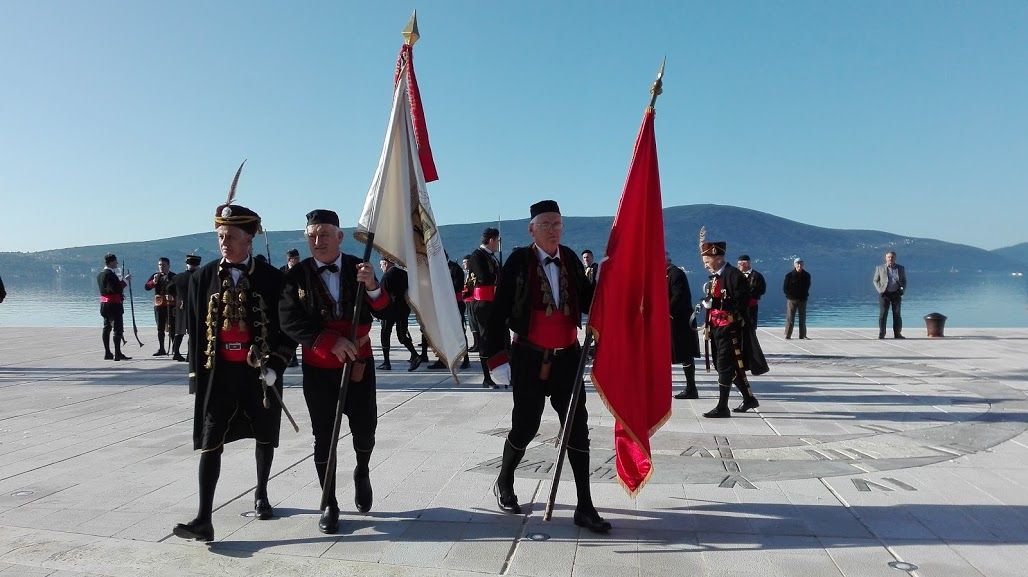 Boka Navy, Tivat, photo by Antonela Stjepcevic
Boka Navy, Tivat, photo by Antonela Stjepcevic Currently, on the territory of the Municipality of Tivat, there are ongoing works on infrastructure and public buildings with a total value of 4.37 million euros.
There is an ongoing adaptation of the building Buca-Lukovic, which is used by the PU Museum and Gallery Tivat worth 176,000 euros. A reconstruction of the Cultural Center facility is being carried out, for which EUR 365,000 was allocated. The construction of the second phase of the MR1 road, which is an investment of 2.98 million, as well as the first phase of the seafront promenade Lungo mare Krasici, worth 747.000 euros, continued on Luštica peninsula. The completion of the first phase of the renovation of the Arsenal auxiliary sports field is ongoing, for which 54,000 euro is committed, which is as much as for the continuation of works on the sewerage in Donja Lastva.
“The municipality has announced a tender worth 665,000 euros, out of which 390,000 is set for the first phase of construction of a facility for children with disabilities in Seljanovo, and 200,000 for the cleaning of the submarine area in the port Kalimanj. The expansion of public lighting in the municipality will cost 40,000, and the purchase of the conference system for the local parliament 35,000 euros," the municipality said.
Tenders worth 2.3 million euros are being prepared, including 700,000 for local road asphalting and 500,000 for the second phase of Belani promenade, i.e. 550,000 euros for the second phase of the facility for children with disabilities. 120.000 euros are for the repair of sidewalks and walkways, and the construction of supporting walls in Gornja Lastva.
Text by Sinisa Lukovic, on February 7th 2019, read more at Vijesti
The merriest Feast in Crmnica and Bar - The Festival of Wine and Ukljeva fish, after several delays, will probably be held the third weekend in February, said the director of Tourist organization of Bar Emil Kukalj.
He told “Vijesti” that this was just one of the activities of TOB this spring, and that they will bring some of the old well-known manifestations back to Bar.
"A rich cultural and entertainment program has been prepared for the Festival of Wine and Ukljeva. Also, TO Bar organizes a concert for Valentine’s Day on February 14th at the Square Vladimir and Kosara. In February, we will present the tourist offer from Bar on the tourism fairs in Munich and Prague and the most important IFT tourism fair in Belgrade," Kukalj said.
In the future activities, TO also included the development of the Tourism Development Strategy of Bar until 2025, which will provide guidelines for further development of tourist offer and promotion and destination’s marketing. Kukalj notes that they have planned to carry out the events "Games Without Boundaries", "Visit the Mountains" and "Days of Grapes".
As he added, a series of well-received and highly-ranked programs continued since the beginning of this year.
This is primarily the three-day New Year's Eve in cooperation with the Municipality of Bar with a variety of entertainment programs and booths with local specialties, and the premiere free of charge ice rink at the square that attracted guests to Bar from all over Montenegro during that month. The TO estimates that there were over 10,000 skaters at the skating rink, and there were about 15,000 visitors at the Square of Vladimir and Kosara during the New Year's concerts.
Text by Radomir Petric, on February 7th 2019, read more at Vijesti
In hotels, tourist resorts and houses throughout Montenegro last year, there were 1,076,848 tourists, out of which 959,121 were foreigners, as shown by the preliminary data from the Monstat Directorate of Statistics, published in “Dnevne novine”.
This is 12.7 percent more than in 2017, while the number of overnight stays is 8.2 percent higher. Namely, there were a total of 4.208.955 overnights and 3.763.857 only by foreign guests.
So, according to the data so far, tourists in Montenegro had an average of 3.91 overnights, which is the closest to a five-day stay, while in July during the peak season they mostly chose a six-day visit with five overnight stays in hotel accommodations. Also, foreigners had an average of 3.92 overnight stays per year and spent the longest 4.98 nights during July.
Unlike them, domestic tourists had an average of 3.78 overnight stays throughout the year, but in August, a favorite month for a collective holiday, they continued to spend an average of 5.24 nights in shared accommodations.
Compared to 2017, the average number of overnight stays dropped for 0.16 from the previous 4.07, and the number of foreign guests by 0.18 from the last year's 4.1, while the Montenegrins spent more nights at hotels, so with 3.86, this number increased by 0.12.
The preliminary data from Monstat show that 809,575, i.e., 84.41 percent of foreign guests arrive from European countries, while from other continents it is 149,546. Of the total number, the highest number of those with a Serbian passport is 120,060 guests or 12.52 percent.
By the number of tourists arriving in Montenegro, Russia is ranked second with 79.153, France with 61.212, and Germany with 57.723 guests. From the United Kingdom, 45,786 guests arrived last year, and other key countries from which there is a significant number of tourists are Poland with 38,419, Italy with 24,833, and Sweden with 20,465 guests who visited the country.
Out of the countries from the region, after Serbia, most of the guests came from Albania 38,281, then Bosnia and Herzegovina 35,101, Croatia 24,816, Kosovo 21,311, Slovenia 15,887, and Macedonia only 10,345. In 2018, there were 22,843 tourists from the USA in Montenegro, from Israel 31,958 and 34,183 from Turkey. Still, this is significantly less than the number of Chinese who have decided to visit Montenegro, i.e. 41,338. Out of 3,763,857 overnights, Europeans achieved 3,447,168 or even 91.59 percent, and spent 4.26 days on average in hotels, resorts, boarding houses, motels, tourist resorts, hostels and other similar accommodation facilities throughout Montenegro.
The two countries whose citizens achieved most of the overnight stays are Serbia with 546,012 or 14.51 percent of the total, then Russia with 514.151 or 13.66 percent of all overnight stays. France is in third place with 313,838 overnight stays, followed by Germany with 240,913 and the United Kingdom with 228,097 overnight stays.
Significant results in hotels are also thanks to guests from Poland who made up 161,632 overnights, Bosnia and Herzegovina with 149,268 and Sweden with 112,497 overnight stays. When it comes to the length of stay, the Serbs stayed an average of 4.55 nights, Russians 6.5, French 5.13, Germans 4.17, and British 4.98 nights. Guests from Poland have an average of 4.21 nights, Bosnia and Herzegovina 4.25, and Sweden 5.5 nights.
Out of the countries in the region, citizens from Albania realized 73,804 nights, Kosovo 62,318, Croatia 56,990, and Slovenia 48,289 nights. This means that the neighbors from Slovenia spend on average 3.04 nights, Kosovo 2.92, Croatia 2.3, and Albania only 1.93 nights. When it comes to other European countries with a significant number of arrivals, Italians have only 65,419 overnight stays, as they spend an average of 2.63 nights on average.
Text by Dnevne novine, on February 7th 2019, read more at CdM
The Ministry of Defense is going to renew the Army of Montenegro's (VCG) stock of motor vehicles, as concluded from the Public Procurement Plan worth slightly over EUR 14 million. For the purchase of goods, it is planned to allocate 9.4 million euros, while works on military facilities in Bar, Niksic, Danilovgrad, Pljevlja, Lepetani and Brezovik will cost 1.74 million, while for payment of various services about three million euros will be spent.
The plan does not foresee the purchase of any significant new weapon or combat system for VCG units but is the money to start the long-announced gradual restoration of obsolete fleet of non-war military vehicles, most of which date back from SFR Yugoslavia.
Thus, for the purchase of new military field trucks of up to five tons, the planned amount of one million euros and another 1.23 million for new lightweight terrain vehicles for the transport of personnel and equipment, sanitary vehicles and water and fuel tanks.
Predrag Bošković's department earlier announced that the key project which they are planning to realize this year, is the purchase of a total of 67 light armored vehicles for the purposes of the Land Forces, for which they intend to take a credit arrangement directly from the manufacturer who will give them the most favorable offer in the total amount of up to 30 million euros.
These items are not included in the public procurement plan of MO for 2019, as it was not the case last year with the purchase of three new multi-purpose helicopters, which were also bought for a 30m-euro loan and repaid by the Ministry of Finance directly.
However, in the area of public procurement, the item for the "purchase of armored vehicles" is stated, but the amount of 600,000 euros that is envisaged for it is sufficient only for the possible purchase of a new "Otocar Cobra" type vehicle that was already bought two years ago with the exclusive purpose of radiological-chemical-biological scanning.
For the purchase of ammunition of various calibers for exercise and maneuvering, MO will spend 550,000 euros, while for the purchase of new personal optoelectronic equipment for members of the declared forces for inter-operative processing will be allocated 980,000 euros. For special equipment for the VCG mountain units the MO will allocate 400,000, for the campfire equipment 50,000, for underwater gear crew members of the Navy VCG 280,000, while the new ABHO protective gear will cost 100,000 euros.
All military and civilian vehicles in VCG and MO, Helicopters and Navy ships will have a total of 445,000 euros available for the fuel expenses.
Text by Sinisa Lukovic, on February 6th 2019, read more at Vijesti
February 7, 2019 - According to the architect Dr Boris Ilijanic, Arza fortress is a protected cultural monument, and no one is allowed to do any intervention on the object without the consent of the Management Board for the Protection of Cultural Monuments.
 Luxury project of Arza Cape Resort, animation
Luxury project of Arza Cape Resort, animation The Fund for the Reform of the Defense System of the State Union of Serbia and Montenegro sold the fort of Arza
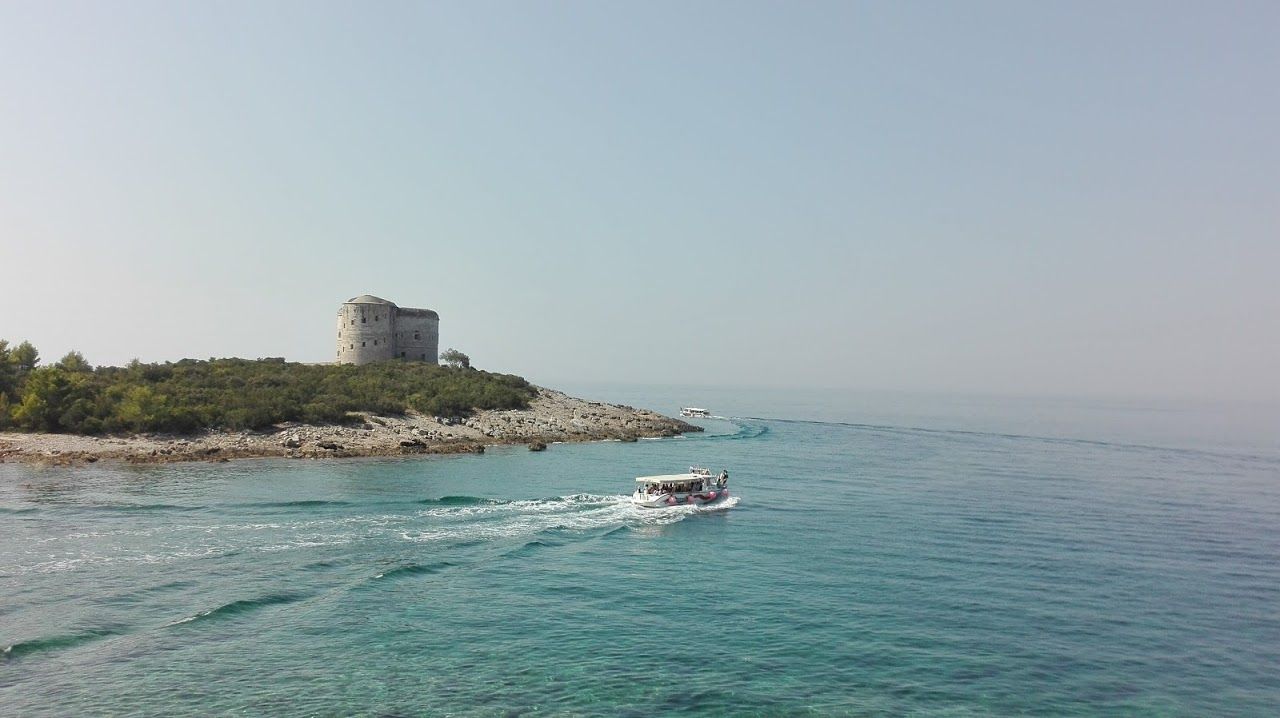 Arza Fortress on the Cape of Miriste, photo by Antonela Stjepcevic
Arza Fortress on the Cape of Miriste, photo by Antonela Stjepcevic By the Constitution, all fortresses, including Arza, are protected cultural monuments
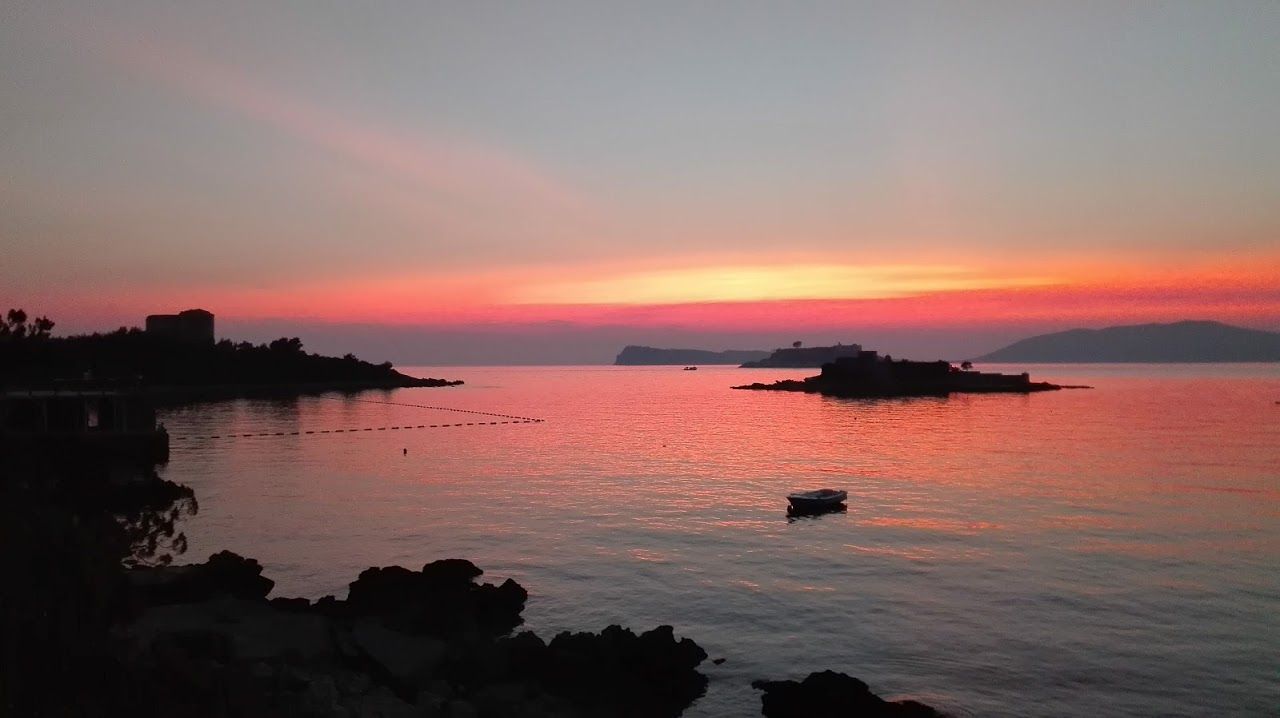 Fortresses Ostro, Mamula and Arza are marking the entrance to Boka Bay, photo by Antonela Stjepcevic
Fortresses Ostro, Mamula and Arza are marking the entrance to Boka Bay, photo by Antonela Stjepcevic February 6, 2019 - NGO Expeditio - Center for Sustainable Spatial Development within the project "Activating the Potential of Open Public Space for Improving the Quality of Life in Kotor" is implementing an informative and educational campaign on social networks aiming to raise the awareness of citizens and institutions about the values and potentials of public spaces in Kotor.
February 6, 2019 - Maskare costume balls and carnivals have been an integral part of the Mimosa Festival since the first edition of this manifestation held in Herceg Novi fifty years ago. For this segment of the program, NGO Maskare, an organization that Herceg Novi owes to listing this city on the map of European carnival cities, is traditionally in charge of this segment of the program. It is a map to which this city, as well as many other Mediterranean traditions, certainly belongs.
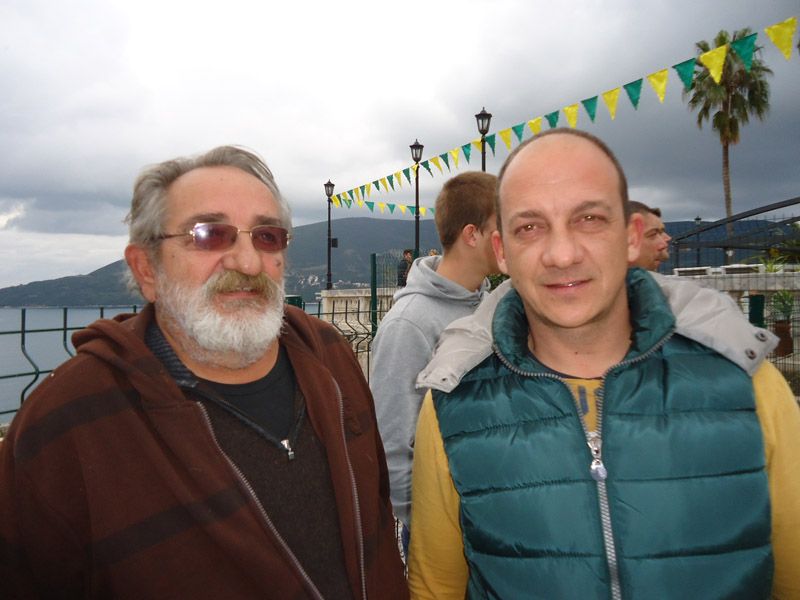 Ivan Peulic and his father, NGO Maskare Herceg Novi, Copyright: radio herceg Novi
Ivan Peulic and his father, NGO Maskare Herceg Novi, Copyright: radio herceg Novi 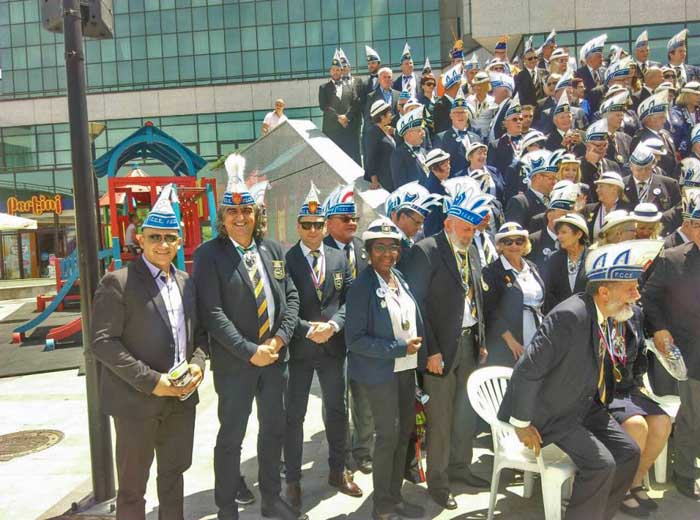 Federation of European Carnival Cities, Sabac, Serbia, private collection of NGO Maskare
Federation of European Carnival Cities, Sabac, Serbia, private collection of NGO Maskare 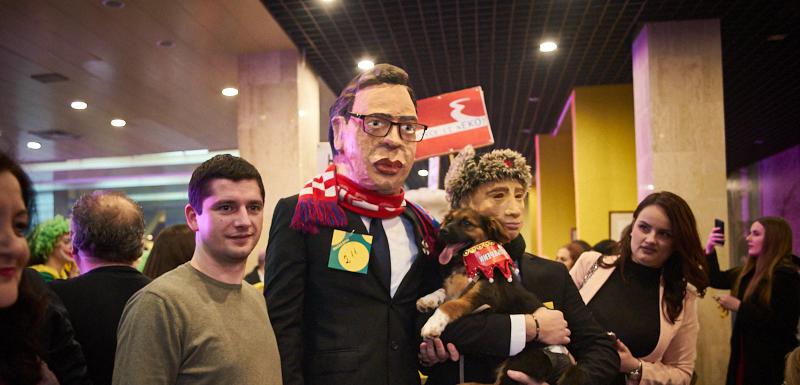 The winning mask of the costume ball in Igalo: Vucic and Putin, Copyright: Radio Jadran
The winning mask of the costume ball in Igalo: Vucic and Putin, Copyright: Radio Jadran 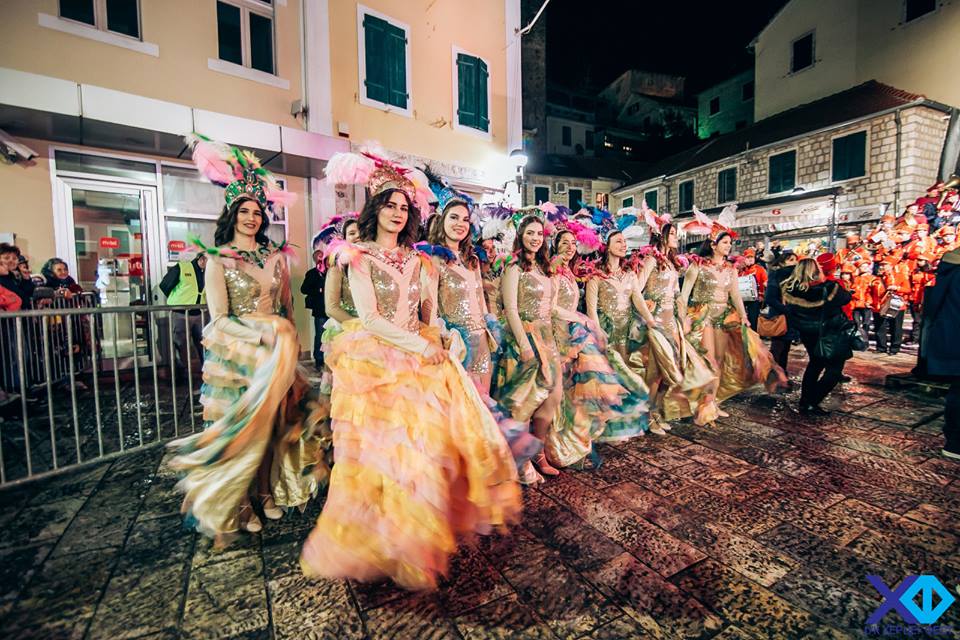 International Carnival in Herceg Novi 2018, Copyright: Herceg Fest
International Carnival in Herceg Novi 2018, Copyright: Herceg Fest 






